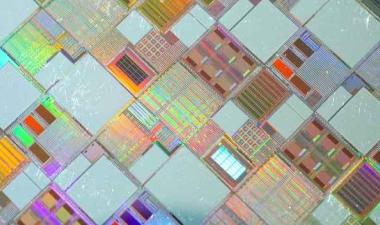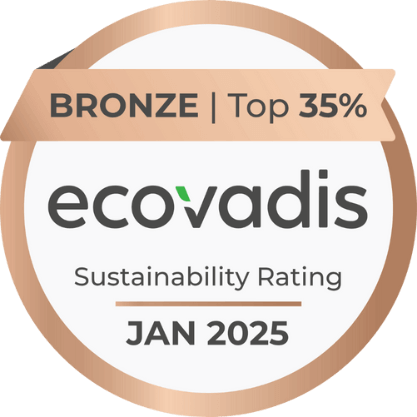Semiconductor Sustainability – Eight Moments that Mattered in 2024
![]()
Looking back on sustainability developments of the past year, from NVIDIA innovations to legal challenges for emissions reporting, Apple net-zero progress to the release of the first global semiconductor carbon emissions forecast.
February 2024
IEA Energy Innovation Forum a Springboard for Sustainability Action
The International Energy Agency (IEA) Energy Innovation Forum in February in Paris marked a pivotal moment in the global dialogue on sustainable energy. This event, coinciding with the IEA's 50th anniversary, wasn't just a milestone; it was a springboard for action, focusing on the critical role technology plays in accelerating the global transition to a secure, sustainable, and affordable energy future.
The forum tackled some of the challenges facing clean energy technologies as they move from innovation labs to widespread adoption. Discussions revolved around bolstering support for developers and innovators, bridging the gap between invention and implementation, and fostering an environment where sustainable solutions can thrive.
One key theme was the need to accelerate innovation and deployment across all clean energy sectors. This includes scaling-up existing technologies like renewable energy and energy efficiency, while also nurturing promising newcomers like carbon capture and storage and hydrogen. Governments were urged to create supportive policy frameworks and incentives, while companies were encouraged to increase their investments in research and development (R&D) and collaboration. Most of the discussion focused on energy infrastructure, but we should expect that many of the applications will have links to energy-intensive industries, including semiconductor manufacturing.
April 2024
Can AI Microprocessors be Sustainable? New NVIDIA Blackwell Chip Points to a Breakthrough for High Tech Industry
Nvidia’s announcement of the anticipated Blackwell Hopper series of GPUs in March had tech leaders salivating to get their hands on these new chips that promise to deliver the processing power needed by AI, but now at a lower cost to manufacture and lower electricity requirements to run. The claim that they will run with 25x less energy consumption sounds like a giant step forward for semiconductors becoming more efficient and sustainable.
If only that was the only lever needing be pulled to reduce the carbon footprint of semiconductors. Other elements that need to be considered include manufacturing for these advanced nodes, the e-waste they will drive as older tech is retired, and even the energy costs of data centers that support them.
To see more on that breakdown, as well as additional information on how manufacturing impacts might counterbalance gains made in efficiency, read our full report in the Platform.
May 2024
SEC Court Challenge Sidetracks Emissions Reporting Requirements
The U.S. Securities and Exchange Commission (SEC) announcement in April that they will be pausing implementation of their new climate disclosure rules while they defend them against legal challenges is further evidence of how difficult it is for companies to perform full cradle-to-grave emissions analysis and how motivated some might be to resist. Focusing just on the products containing semiconductors, this challenge highlights the extreme complexity of their manufacture, as well as the extensive supply chain they require.
This will likely be seen as a setback for parties keen to see adoption of sustainability standards in a variety of industries. Doubly so when it was only a month ago that the SEC announced they were dropping the requirement for Scope 3 emissions from their proposed corporate climate risk rules. The SEC will certainly have its day in court, but the broader issue is understanding the complexity of the reporting requirements they plan to implement and helping companies understand how they can become part of the solution.
Tracking Scope 3 emissions is notoriously tough for companies, but even a half effort could provide meaningful benefits. An article by PwC suggests that 80% of supply chain emissions typically come from 20% of a company’s purchases. Focusing on these largest contributions and using accurate sustainability tools to provide carbon footprint calculations could reduce the burden created by future SEC reporting requirements.
August 2024
The Looming Shadow of AI on Semiconductor Sustainability
The rapid advancement of artificial intelligence (AI) is ushering in a new era of technological innovation. However, this progress comes with a significant environmental cost, particularly in terms of energy consumption and carbon emissions. At the heart of this challenge lies the semiconductor industry, which is struggling to keep pace with the insatiable appetite of AI for computing power.
Data centers, the backbone of AI, are facing an unprecedented surge in energy demand. Driven primarily by AI accelerators like GPUs, these facilities are rapidly becoming major contributors to global carbon emissions. TechInsights forecasts a staggering 300% increase in CO2 emissions from AI accelerators alone between 2025 and 2029. This alarming trend highlights the urgent need for sustainable solutions.
TechInsights Senior Technical Fellow Stephen Russell’s full report on AI data centers and sustainability in August detailed the challenges of achieving semiconductor sustainability and how the industry is incorporating sustainability goals into plans to ramp up data centers that support power-hungry AI programs.
September 2024
Making the Case to Adopt Renewable Energy in Fabs
TSMC requires energy and a lot of it. To complicate matters, many of TSMC’s customers are requiring the company to reduce its carbon emissions in the face of increasingly electricity intensive wafer fabrication for advanced processes. In response to these two pressing challenges, TSMC last year announced an acceleration of its RE100 sustainability goals, moving its target for 100% renewable energy consumption across all global operations from 2050 to 2040. Additionally, TSMC increased its 2030 goal for company-wide renewable energy usage to 60%, up from the previous target of 40%.
To better understand the acceleration of this timeline, TechInsights completed an analysis on a 3nm process for a TSMC fab with capacity of 60,000 wafers per month located in Taiwan. Using TechInsights’ Manufacturing Carbon Module, our team input the following assumptions, using 2023 as the baseline year:
- 90% utilization
- 95% fab abatement
- 4.8% renewable energy usage
Read more in the full report: Making the Case to Adopt Renewable Energy in Fabs | TechInsights
October 2024
Biden’s New Law Exempts Semiconductor Fabs from Environmental Review
On Oct. 2, 2024, U.S. President Biden signed a new law exempting semiconductor manufacturing facilities from undergoing federal environmental reviews. These reviews are part of the National Environmental Policy Act (NEPA) of 1969 to win federal permits. This exemption from NEPA applies to those projects funded by the CHIPS and Science Act of 2022. The move represents a push and pull between rapidly building out semiconductor chip manufacturing capabilities onshore and ensuring these fabs are built with environmentally supportive practices.
The United States is amid a massive effort to regain a stronghold of semiconductor fabrication. At the end of 2024, TechInsights expects the U.S. to produce just over 10 percent of all chips globally. To ensure technological innovation in the United States thrives, the focus of the CHIPS and Science Act aims to develop these advanced technologies as well as skills and revenue onshore – and derisk the dependence on other regions to develop the chips that power consumer devices, enterprise applications, and military equipment. Not only will this $52B chip investment boost the economy, but it also protects the U.S. against an evolving geopolitical landscape.
The CHIPS Act is driving U.S. buildouts for both domestic and international vendors. Without the NEPA reviews, it will be interesting to see if attention to environmental elements related to construction, and eventual chip production, will be adversely affected. The semiconductor chip manufacturing industry is global, and environmental requirements are imposed to varying levels across different geographies. Europe is arguably the most progressive in terms of environmental advocacy and sustainable technology reporting requirements. Because the semiconductor supply chain is highly interconnected, vendors further downstream will be looking upstream to the fabs that manufacture the chips used in their products to provide Scope 3 emissions data as part of their reporting requirements. Foundries and their associated fab locations will increasingly weigh into investment decisions as companies throughout the semiconductor supply chain look to meet net zero emission commitments. Despite the lax requirements for CHIPS Act awardees, they must still consider the longer-term implications of customer sustainability requirements and local community impact, to name a few. Read the full story here.
October 2024
Apple's Sustainability Efforts: A Closer Look
TechInsights explored Apple's sustainability efforts and challenges in reducing semiconductor emissions, including the carbon neutrality of the Apple Watch Series 10, in an October report on progress toward their 2030 net-zero goal.
Apple has made significant strides in its sustainability initiatives, but the challenges of reducing semiconductor emissions remain substantial. As the company continues to push the boundaries of technological innovation, it's essential to evaluate the environmental impact of its products and manufacturing processes.
While Apple's latest product announcements haven't showcased groundbreaking sustainability features, there have been incremental improvements. The Apple Watch Series 10's carbon neutrality, achieved through the use of carbon credits, is a positive step. However, the iPhone 16 series has demonstrated minimal changes in emissions compared to its predecessors.
For details and analysis on what Apple has done to reduce its Scope 3 emissions and future sustainability efforts they will need to address the environmental impact of data centers, read our full report.
December 2024
TechInsights Issues Industry’s First Global Semiconductor Carbon Emissions Forecast
In a move that promises to set the pace for semiconductor sustainability, TechInsights in December released the first ever Global Semiconductor Carbon Emissions Forecast, 2025-2030, with analysis showing an expected release of 277 million metric tons of CO₂e in 2030.
The semiconductor industry is undergoing rapid growth. However, this expansion comes with significant environmental implications. To set the bar for semiconductor sustainability and provide analysis and leadership to address the industry's carbon footprint, TechInsights has developed the Global Semiconductor Carbon Emissions Forecast, 2025-2030.
TechInsights' comprehensive global forecast provides a granular analysis of semiconductor emissions from 2025 to 2030, considering factors like technology node, device type, and regional variations. By leveraging data on silicon shipments and outputs from the EcoInsights product suite, the forecast sheds light on the key trends shaping the industry's environmental impact.
By providing a detailed breakdown of semiconductor emissions, TechInsights' thought leadership and data-driven analysis (powered by our EcoInsights sustainability tools) has produced the industry’s first carbon emissions forecast. It provides an objective bar to measure progress over the next five, very critical, years. For more detail and the data behind it, read the full Global Semiconductor Carbon Emissions Forecast, 2025-2030.













